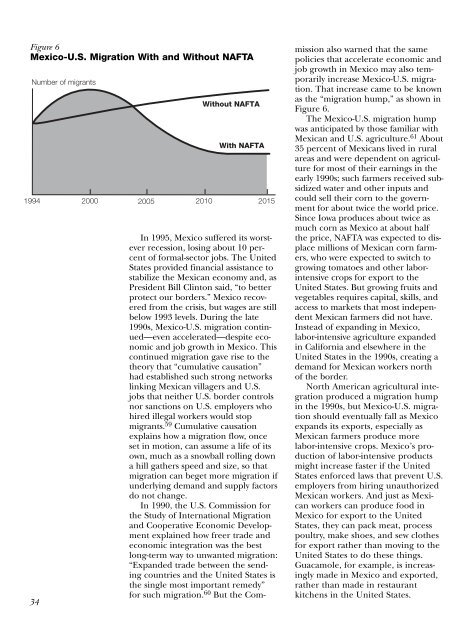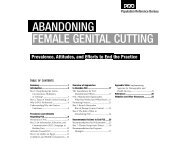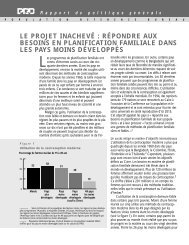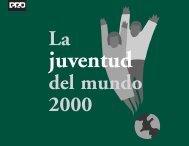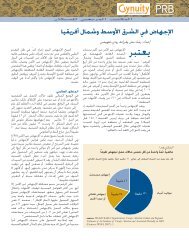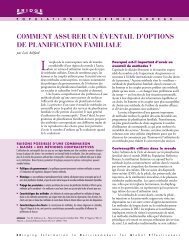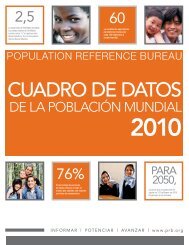Immigration Shaping America - Population Reference Bureau
Immigration Shaping America - Population Reference Bureau
Immigration Shaping America - Population Reference Bureau
Create successful ePaper yourself
Turn your PDF publications into a flip-book with our unique Google optimized e-Paper software.
Figure 6<br />
Mexico-U.S. Migration With and Without NAFTA<br />
Number of migrants<br />
34<br />
Without NAFTA<br />
With NAFTA<br />
1994 2000 2005 2010 2015<br />
In 1995, Mexico suffered its worstever<br />
recession, losing about 10 percent<br />
of formal-sector jobs. The United<br />
States provided financial assistance to<br />
stabilize the Mexican economy and, as<br />
President Bill Clinton said, “to better<br />
protect our borders.” Mexico recovered<br />
from the crisis, but wages are still<br />
below 1993 levels. During the late<br />
1990s, Mexico-U.S. migration continued—even<br />
accelerated—despite economic<br />
and job growth in Mexico. This<br />
continued migration gave rise to the<br />
theory that “cumulative causation”<br />
had established such strong networks<br />
linking Mexican villagers and U.S.<br />
jobs that neither U.S. border controls<br />
nor sanctions on U.S. employers who<br />
hired illegal workers would stop<br />
migrants. 59 Cumulative causation<br />
explains how a migration flow, once<br />
set in motion, can assume a life of its<br />
own, much as a snowball rolling down<br />
a hill gathers speed and size, so that<br />
migration can beget more migration if<br />
underlying demand and supply factors<br />
do not change.<br />
In 1990, the U.S. Commission for<br />
the Study of International Migration<br />
and Cooperative Economic Development<br />
explained how freer trade and<br />
economic integration was the best<br />
long-term way to unwanted migration:<br />
“Expanded trade between the sending<br />
countries and the United States is<br />
the single most important remedy”<br />
for such migration. 60 But the Commission<br />
also warned that the same<br />
policies that accelerate economic and<br />
job growth in Mexico may also temporarily<br />
increase Mexico-U.S. migration.<br />
That increase came to be known<br />
as the “migration hump,” as shown in<br />
Figure 6.<br />
The Mexico-U.S. migration hump<br />
was anticipated by those familiar with<br />
Mexican and U.S. agriculture. 61 About<br />
35 percent of Mexicans lived in rural<br />
areas and were dependent on agriculture<br />
for most of their earnings in the<br />
early 1990s; such farmers received subsidized<br />
water and other inputs and<br />
could sell their corn to the government<br />
for about twice the world price.<br />
Since Iowa produces about twice as<br />
much corn as Mexico at about half<br />
the price, NAFTA was expected to displace<br />
millions of Mexican corn farmers,<br />
who were expected to switch to<br />
growing tomatoes and other laborintensive<br />
crops for export to the<br />
United States. But growing fruits and<br />
vegetables requires capital, skills, and<br />
access to markets that most independent<br />
Mexican farmers did not have.<br />
Instead of expanding in Mexico,<br />
labor-intensive agriculture expanded<br />
in California and elsewhere in the<br />
United States in the 1990s, creating a<br />
demand for Mexican workers north<br />
of the border.<br />
North <strong>America</strong>n agricultural integration<br />
produced a migration hump<br />
in the 1990s, but Mexico-U.S. migration<br />
should eventually fall as Mexico<br />
expands its exports, especially as<br />
Mexican farmers produce more<br />
labor-intensive crops. Mexico’s production<br />
of labor-intensive products<br />
might increase faster if the United<br />
States enforced laws that prevent U.S.<br />
employers from hiring unauthorized<br />
Mexican workers. And just as Mexican<br />
workers can produce food in<br />
Mexico for export to the United<br />
States, they can pack meat, process<br />
poultry, make shoes, and sew clothes<br />
for export rather than moving to the<br />
United States to do these things.<br />
Guacamole, for example, is increasingly<br />
made in Mexico and exported,<br />
rather than made in restaurant<br />
kitchens in the United States.


